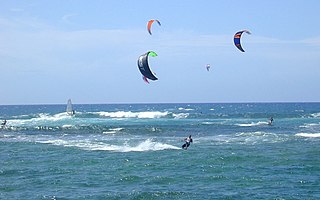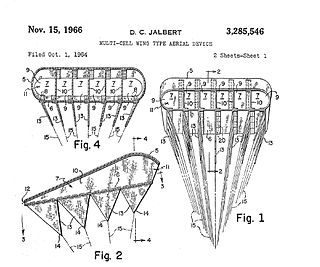
A hot air balloon is a lighter-than-air aircraft consisting of a bag, called an envelope, which contains heated air. Suspended beneath is a gondola or wicker basket, which carries passengers and a source of heat, in most cases an open flame caused by burning liquid propane. The heated air inside the envelope makes it buoyant, since it has a lower density than the colder air outside the envelope. As with all aircraft, hot air balloons cannot fly beyond the atmosphere. The envelope does not have to be sealed at the bottom, since the air inside the envelope is at about the same pressure as the surrounding air. In modern sport balloons the envelope is generally made from nylon fabric, and the inlet of the balloon is made from a fire-resistant material such as Nomex. Modern balloons have been made in many shapes, such as rocket ships and the shapes of various commercial products, though the traditional shape is used for most non-commercial and many commercial applications.

A parachute is a device used to slow the motion of an object through an atmosphere by creating drag or, in a ram-air parachute, aerodynamic lift. A major application is to support people, for recreation or as a safety device for aviators, who can exit from an aircraft at height and descend safely to earth.

Paragliding is the recreational and competitive adventure sport of flying paragliders: lightweight, free-flying, foot-launched glider aircraft with no rigid primary structure. The pilot sits in a harness or lies prone in a cocoon-like 'pod' suspended below a fabric wing. Wing shape is maintained by the suspension lines, the pressure of air entering vents in the front of the wing, and the aerodynamic forces of the air flowing over the outside.

A pulsejet engine is a type of jet engine in which combustion occurs in pulses. A pulsejet engine can be made with few or no moving parts, and is capable of running statically. The best known example may be the Argus As 109-014 used to propel Nazi Germany's V-1 flying bomb.
A torpedo tube is a cylindrical device for launching torpedoes.

A power kite or traction kite is a large kite designed to provide significant pull to the user.

An inflatable is an object that can be inflated with a gas, usually with air, but hydrogen, helium, and nitrogen are also used. One of several advantages of an inflatable is that it can be stored in a small space when not inflated, since inflatables depend on the presence of a gas to maintain their size and shape. Function fulfillment per mass used compared with non-inflatable strategies is a key advantage. Stadium cushions, impact guards, vehicle wheel inner tubes, emergency air bags, and inflatable space habitats employ the inflatable principle. Inflation occurs through several strategies: pumps, ram-air, blowing, and suction.

In aircraft, an ejection seat or ejector seat is a system designed to rescue the pilot or other crew of an aircraft in an emergency. In most designs, the seat is propelled out of the aircraft by an explosive charge or rocket motor, carrying the pilot with it. The concept of an ejectable escape crew capsule has also been tried. Once clear of the aircraft, the ejection seat deploys a parachute. Ejection seats are common on certain types of military aircraft.

A buoyancy compensator (BC), also called a buoyancy control device (BCD), stabilizer, stabilisor, stab jacket, wing or adjustable buoyancy life jacket (ABLJ), depending on design, is a type of diving equipment which is worn by divers to establish neutral buoyancy underwater and positive buoyancy at the surface, when needed.

A powered parachute, often abbreviated PPC, and also called a motorized parachute or paraplane, is a type of aircraft that consists of a parafoil with a motor and wheels.

In aeronautics, an environmental control system (ECS) of an aircraft is an essential component which provides air supply, thermal control and cabin pressurization for the crew and passengers. Additional functions include the cooling of avionics, smoke detection, and fire suppression.

A parafoil is a nonrigid (textile) airfoil with an aerodynamic cell structure which is inflated by the wind. Ram-air inflation forces the parafoil into a classic wing cross-section. Parafoils are most commonly constructed out of ripstop nylon.

An escape trunk is a small compartment on a submarine which provides a means for crew to escape from a downed submarine; it operates on a principle similar to an airlock, in that it allows the transfer of persons or objects between two areas of different pressure.

An air-supportedstructure is any building that derives its structural integrity from the use of internal pressurized air to inflate a pliable material envelope, so that air is the main support of the structure, and where access is via airlocks.

A jack is a mechanical lifting device used to apply great forces or lift heavy loads. A mechanical jack employs a screw thread for lifting heavy equipment. A hydraulic jack uses hydraulic power. The most common form is a car jack, floor jack or garage jack, which lifts vehicles so that maintenance can be performed. Jacks are usually rated for a maximum lifting capacity. Industrial jacks can be rated for many tons of load.

An evacuation slide is an inflatable slide used to evacuate an aircraft quickly. An escape slide is required on all commercial aircraft where the door sill height is such that, in the event of an evacuation, passengers would be unable to step down from the door uninjured.
A tubeless tire is a pneumatic tire that does not require a separate inner tube.

The ram-air inflatable single-line kite is one of the few modern inventions in the world of kite design. Although Francis Rogallo's early kite patents had ram-air members in the claims, Domina Jalbert's parafoil ram-air wing, patented in 1944, emphatically changed the kite airscape for inflatable kites.

A lifeboat or liferaft is a small, rigid or inflatable boat carried for emergency evacuation in the event of a disaster aboard a ship. Lifeboat drills are required by law on larger commercial ships. Rafts (liferafts) are also used. In the military, a lifeboat may double as a whaleboat, dinghy, or gig. The ship's tenders of cruise ships often double as lifeboats. Recreational sailors usually carry inflatable liferafts, though a few prefer small proactive lifeboats that are harder to sink and can be sailed to safety.
Daedalus Project is a brand of high-performance and competition skydiving parachutes designed and manufactured by New Zealand manufacturer NZ Aerosports Ltd, for the sport of Canopy piloting.
















